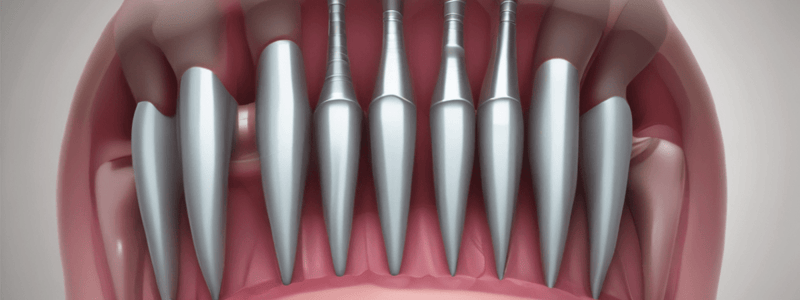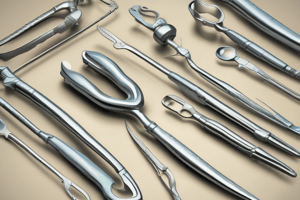Podcast
Questions and Answers
What is the primary function of the shank in a hand cutting instrument?
What is the primary function of the shank in a hand cutting instrument?
- To facilitate delicate manipulation
- To connect the handle to the working end (correct)
- To provide a surface for gripping
- To enhance the cutting edge
What is the typical diameter of a handle in a hand cutting instrument?
What is the typical diameter of a handle in a hand cutting instrument?
- 5.5 mm (correct)
- 3.5 mm
- 10.5 mm
- 7.5 mm
What is the main characteristic of a nib-ending instrument?
What is the main characteristic of a nib-ending instrument?
- It has a tapered shank
- It has a round handle
- It has a non-cutting working end (correct)
- It has a cutting edge
What is the purpose of the eight-sided or knurled handle in hand cutting instruments?
What is the purpose of the eight-sided or knurled handle in hand cutting instruments?
What is the classification of hand instruments used in operative procedures that includes mirrors and dental explorers?
What is the classification of hand instruments used in operative procedures that includes mirrors and dental explorers?
What is the primary characteristic of a rotary cutting instrument?
What is the primary characteristic of a rotary cutting instrument?
What is the main function of restorative instruments?
What is the main function of restorative instruments?
What is the primary purpose of Balance Contra-angling in instruments?
What is the primary purpose of Balance Contra-angling in instruments?
What is the maximum allowed deviation of the blade edge from the axis for optimal anti-rotational design?
What is the maximum allowed deviation of the blade edge from the axis for optimal anti-rotational design?
What is the primary cutting edge of a single-beveled instrument?
What is the primary cutting edge of a single-beveled instrument?
What does the first number in an instrument formula represent?
What does the first number in an instrument formula represent?
What is the purpose of the manufacturer's identification number on the handle?
What is the purpose of the manufacturer's identification number on the handle?
What is the unit of measurement for the blade length in the instrument code?
What is the unit of measurement for the blade length in the instrument code?
What is the term for instruments with two bends?
What is the term for instruments with two bends?
What is the purpose of excavators in dentistry?
What is the purpose of excavators in dentistry?
What is the term for the edges that extend from the primary edge in single-beveled instruments?
What is the term for the edges that extend from the primary edge in single-beveled instruments?
What is the angle in the instrument code measured relative to?
What is the angle in the instrument code measured relative to?
What type of instrument is used for cutting enamel?
What type of instrument is used for cutting enamel?
What is the result of omitting the edge angle when it is perpendicular to the blade?
What is the result of omitting the edge angle when it is perpendicular to the blade?
How is the blade angle expressed in the instrument code?
How is the blade angle expressed in the instrument code?
What type of chisel is used for trimming the gingival margin?
What type of chisel is used for trimming the gingival margin?
What is the purpose of angle-formers in dentistry?
What is the purpose of angle-formers in dentistry?
Flashcards are hidden until you start studying
Study Notes
Instrument Formula and Design
- Instrument formula describes the dimensions and angles of the working end in a code of three or four numbers separated by dashes or spaces.
- The first number represents the width of the blade or length of the cutting edge in tenths of a millimeter.
- The second number represents the primary cutting edge angle, measured from a line parallel to the long axis of the instrument handle in clockwise centigrade.
- The third number represents the blade length in millimeters.
- The fourth number represents the blade angle, relative to the long axis of the handle in clockwise centigrade.
Instrument Classification
- Hand instruments used in operative procedures can be classified into:
- Diagnostic Instruments (e.g., mirrors, dental explorers)
- Cutting Instruments (e.g., hand cutting, rotary cutting, ultrasonic, laser equipment)
- Restorative Instruments (e.g., used for manipulation, packing, or condensation and shaping of restorative materials)
Cutting Instruments
- Hand Cutting Instruments are classified into:
- Ordinary hatchets
- Hoes
- Angle-formers
- Spoons excavators
- Chisels (e.g., straight, slightly curved, bin-angle)
- Enamel hatchets
- Gingival margin trimmers
- Bi-beveled instruments have two bevels that form the cutting edge.
- Single bevel instruments form the primary cutting edge at the end of the blade, with two additional secondary cutting edges extending from the primary edge.
Instrument Design
- An instrument consists of three main parts: shaft (handle), shank (neck), and blade (working end).
- The handle should be small in diameter (5.5 mm), light in weight, and have an eight-sided or knurled surface to facilitate control.
- The shank serves to connect the handle to the working end of the instrument and is normally smooth, round, and tapered.
Studying That Suits You
Use AI to generate personalized quizzes and flashcards to suit your learning preferences.



